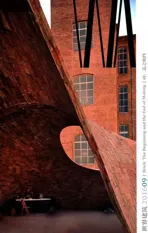砖:墙、粘土与乐高
2016-04-11张利ZHANGLi
张利/ZHANG Li
砖:墙、粘土与乐高
Bricks: Wall, Clay or Lego
张利/ZHANG Li
在今年奥斯陆建筑三年展的开幕式上,挪威王储哈康在其致辞中出人意料地借用了三只小猪的故事来引喻建筑对居者的基本呵护:用草和木棍的两只小猪都很快盖完了房,但最终都没能抵御狼的袭击,只有用砖、盖得最慢的小猪享受了房屋的保护而存活下来。砖在建筑史上代表材料进步的作用可见一斑。
2016年又是维纳博艮砖筑奖的评奖年。虽然在近年的各种奖项或展览(包括今年的砖筑奖)中我们都能清晰地看到世界经济不景气的印记,但维纳博艮长期所引起的关于砖在建筑中的作用的讨论却并未因此而减弱。事实上,从不同观点争执的程度看,这一讨论变得更激烈了。
争论的焦点是砖在当代建筑中到底是一种什么样的角色,或者说,建筑师们如何看待砖。有一派建筑师坚守砖的“本分”:具有相当大的抗压强度、便于操作的砌块。另一派建筑师则认为在建筑材料技术突飞猛进的今天,砖正逐渐失去其技术优势,而其美学价值,特别是其温暖的质感、气候痕迹所带来的诗意,是永远无法被其他材料所取代的。如果说上述两派在工业化的20世纪就已存在的话,那么还有一派则是自媒体化的21世纪的产物,在这派建筑师的眼里,对砖的“误用”甚至是“滥用”反倒是视觉猎奇的重要源泉。
第一种观点把砖看成是结构性的,它的角色定位就是墙。砖墙,从三只小猪的寓言,到改革开放初期的中国农村,到今天不停更新对环保建筑定义的欧洲城市,都一直是可靠、进步和不过时的围护结构。这种看似保守的观点事实上隐含着一种在我们今天的建筑界呈短缺状态的诚实,而其对砖的技术演进的期待也是更多集中在骨料、复合体和砌筑工艺的改进上。鲍姆施拉格·埃贝尔的2226办公楼获得今年的维纳博艮砖筑奖最重要的奖项传递了一个重要的信息,即砖建筑完全可以通过砌体工法本身的更新来实现建筑学意义上的进步。
第二种观点把砖看成是精神性的,它的角色定位是被建筑模快化了的粘土,连接在有机物与无机物之间的温床,一种“有生命力的非生命体”。从粘土那里继承来的品质——多空隙、易渗透、颗粒感——在高温烧制的过程中被固化,使砖成了记录时间与自然造化的绝佳媒介。时间性通过砖在建筑界面上的寄存,这存在于斯卡帕、沙里宁、路易·康的经典作品里,也存在于王澍重释传统的博物馆里,也存在于巴塞罗那Map13建筑事务所的“砖的乌托邦”这样的当代实验性作品中。
第三种观点把砖看成是装饰性的,而它的角色定位——很不幸——是建筑师的乐高玩具,一种可以用来组合模仿其他事物的三维“像素”。从20世纪的某个时间开始——感谢建筑的“后现代主义”者们在把砖表皮化方面所做的努力——对砖拼接图案的杂技式的竞赛成为一种潮流,而其二维图像友好性(或者说“上相”)无疑为它在快餐媒体时代的大肆流行提供了保证。如果说热带空间的白蚁穴住宅的“网”与热带气候还能扯上关系的话,那么卡艾特工作室的德黑兰卡里扎克公寓楼则仅剩下“看,我又用砖做到了什么”的视觉奇观了。
在砖的故事中,也许“乐高”只是昙花一现,而“墙”与“粘土”的争论则会持续下去。
In his speech on the Oslo Architecture Triennial, the crowned prince of Norway entertained the audience by mentioning the story of three little pigs to while talking about the basic protection provided by buildings: the first two little pigs who built with straw and sticks did not survive the attack of the wolf, the last one who built with bricks. Aside from all the anthropomorphic analogies of the story,the role of bricks as a significant mark of progress in architecture is obvious.
In 2016 we just witnessed another edition of the Wienerberger Brick Award. Although the global economic downturn has taken its toll in awards and exhibition everywhere, the debate of bricks in architecture continues to gain momentum through the Award.
At the centre of the debate, there is the question of what is the role model of bricks in contemporary buildings. There is one school, a more "conventional" one, that insists bricks being the modular units for masonry, which have incredible resistance to pressure. There is another school, almost as "conventional",stating that with the dramatic development in material technology, bricks are losing their technical advantage but they remain as relevant as before because of their irreplaceable warmth and organic features, embedding them with huge poetic potentials.There is yet another school, a rather recent one, that concentrates in the pixelating character of bricks which feeds the vast demand for visual spectacles popularised by 21st century fast media. To architects belonging to the last school, it is the misuse or even abuse of bricks that generates the wow factors.
The first school regards bricks as structural. Its prototypal model is the wall. A solid brick wall has been the symbol of reliable building envelope for centuries, from the fable of the three little pigs, to the changing rural villages in China, to the new sustainable towns in Europe. This seemingly conservative argument represents a certain type of honesty that has been in short supply in contemporary architecture. From this point view,the development of bricks must take place in the aggregation, hybridisation, and connection of bricks. baumschlager eberle's grand award winning project in this year's Wienerberger Award sends a clear message: progressive architecture can be achieved solely by using bricks.
The second schools regards bricks as spiritual. Its prototypal model is the clay. Clay is a charming material that links the non-organic world and the organic one. Clay itself, as put by some artists,"has a life without being alive". Physical features inherited from clay, such as permeability, porosity and fine-graininess, make bricks the best material to register time and natural processes in buildings. Scarpa, Saarinen and Kahn all have used the brick to register time. WANG Shu also did so in his dramatic re-interpretations of traditional buildings in his museum in Ningbo. Recently, Map13 Barcelona has done it again in their contemporary installation the "Brick-topia".
The third school regard bricks as ornamental. Its prototypal model is, well, Lego-ish. Bricks become the ideal 3D pixels in buildings, ready to feed the highly image-thirsty world. Thanks to the works of architecture postmodernists somewhere in the last century, the excessive use of brick patterns as decoration emerged as a fashion. In this century,helped by the online media and fast imagery, surface brick architecture has becoming more and more popular. Sometime it is easier to argue for these 2D image-friendly buildings, such as the Termitary House by Tropical Space, when there is a climatic reason. Sometime it is difficult, such as the Kahrizak Residential by Caat Studio with its "I can do this with bricks" kind of experiments.
Maybe, in the coming story of bricks, the "Lego" would go soon. But the dichotomy between "wall" and "clay" might continue.
清华大学建筑学院 /《世界建筑》
2016-09-10
